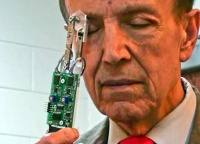The self-test instrument was designed in associate professor Eniko Enikov’s lab at the University of Arizona’s College of Engineering.
’You simply close your eye and rub the eyelid like you might casually rub your eye,’ said Enikov, a professor of aerospace and mechanical engineering. ’The instrument detects the stiffness and, therefore, infers the intraocular pressure.’
While the probe is simple to use, the technology behind it involves a system of sensors, custom ICs and algorithms.
Enikov began working on the probe four years ago in collaboration with Dr Gholan Peyman, a Phoenix ophthalmologist. ’We went through several years of refinement and modifications to arrive at the current design,’ Enikov noted.
The National Science Foundation has funded the work, and Enikov and Peyman now are seeking investors to help fund final development and commercialisation of the product.
In addition to screening for glaucoma, an eye disease that can lead to blindness if left untreated, the device corrects some problems with the current procedure and can be used to measure drainage of intraocular fluid.
’Eye pressure varies over a 24-hour cycle,’ Enikov said. ’So it could be low at the doctor’s office and three hours later it might be high. With only a single test, the doctor might miss the problem. Having the ability to take more frequent tests can lead to earlier detection in some cases.’
Once the diagnosis is made, several treatments are available. The question then is: How effective are they? Patients could use the probe at home to trace how much the pressure decreases after using eye-drop medications, for instance.
’One of the reasons pressure builds up in the eye is because fluid doesn’t drain properly,’ Enikov noted. ’Currently, there are no methods available to test drainage.’
Current tests require applying pressure directly to the cornea, but only very light pressure is safe to use and it doesn’t cause the fluid to drain.
’Our technique allows us to apply slightly greater pressure, but it’s still not uncomfortable,’ he said. ’It’s equivalent to rubbing your eye for a brief period to find out if the pressure changes. If it does, we know by how much and if there is a proper outflow of intraocular fluid.’

Phoenix ophthalmologist Dr Gholan Peyman demonstrates a prototype glaucoma test instrument that’s non-invasive and simpler to use than current procedures
Sometimes, a surgical shunt is used to help fluid drain from the eye. ’The problem with glaucoma shunts is they can plug up over time,’ Enikov noted. ’Or if they’re not properly installed, they may drain too quickly. So you would want to know how well the shunt is working and if it is properly installed. Our device could help answer those questions.’





Swiss geoengineering start-up targets methane removal
No mention whatsoever about the effect of increased methane levels/iron chloride in the ocean on the pH and chemical properties of the ocean - are we...